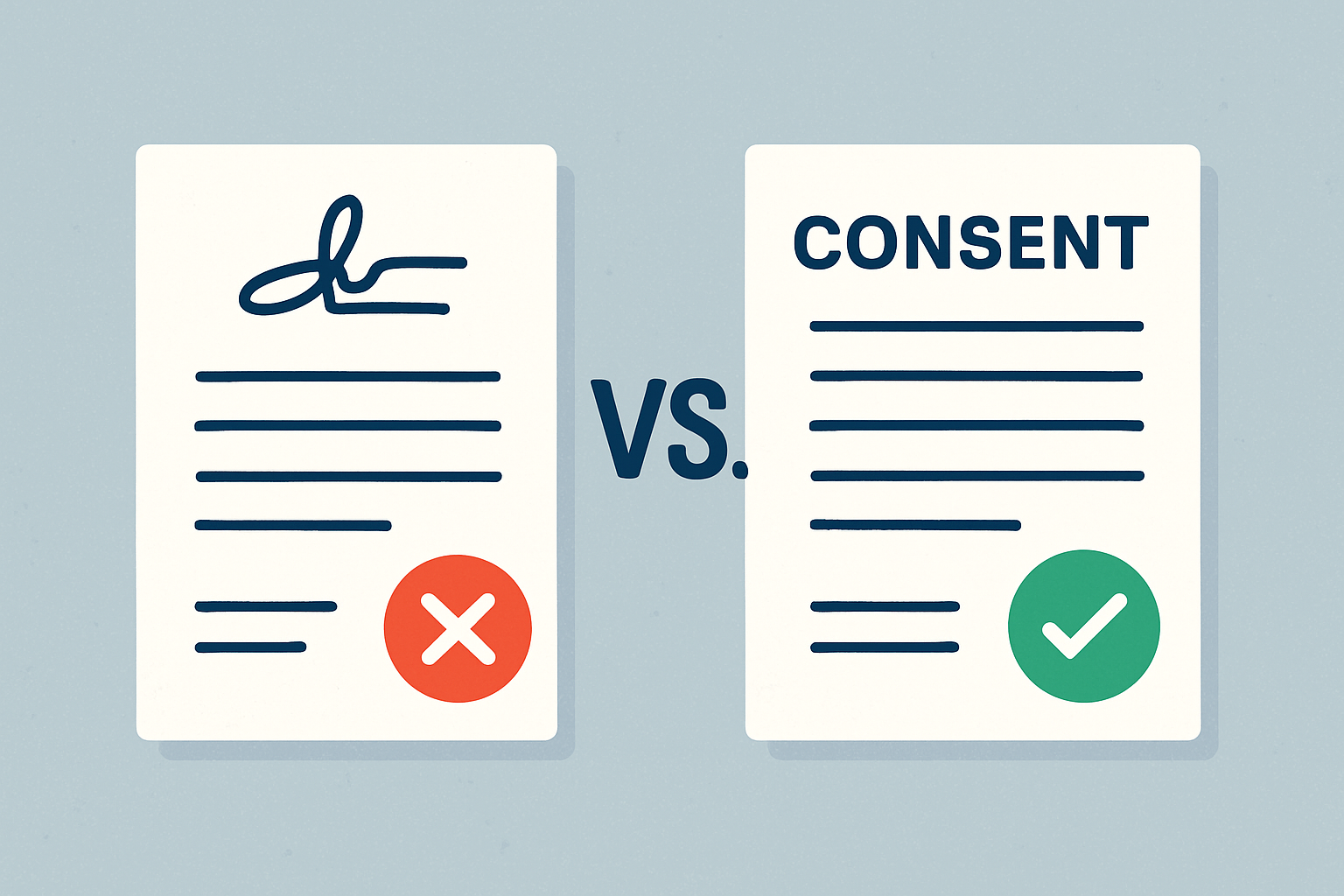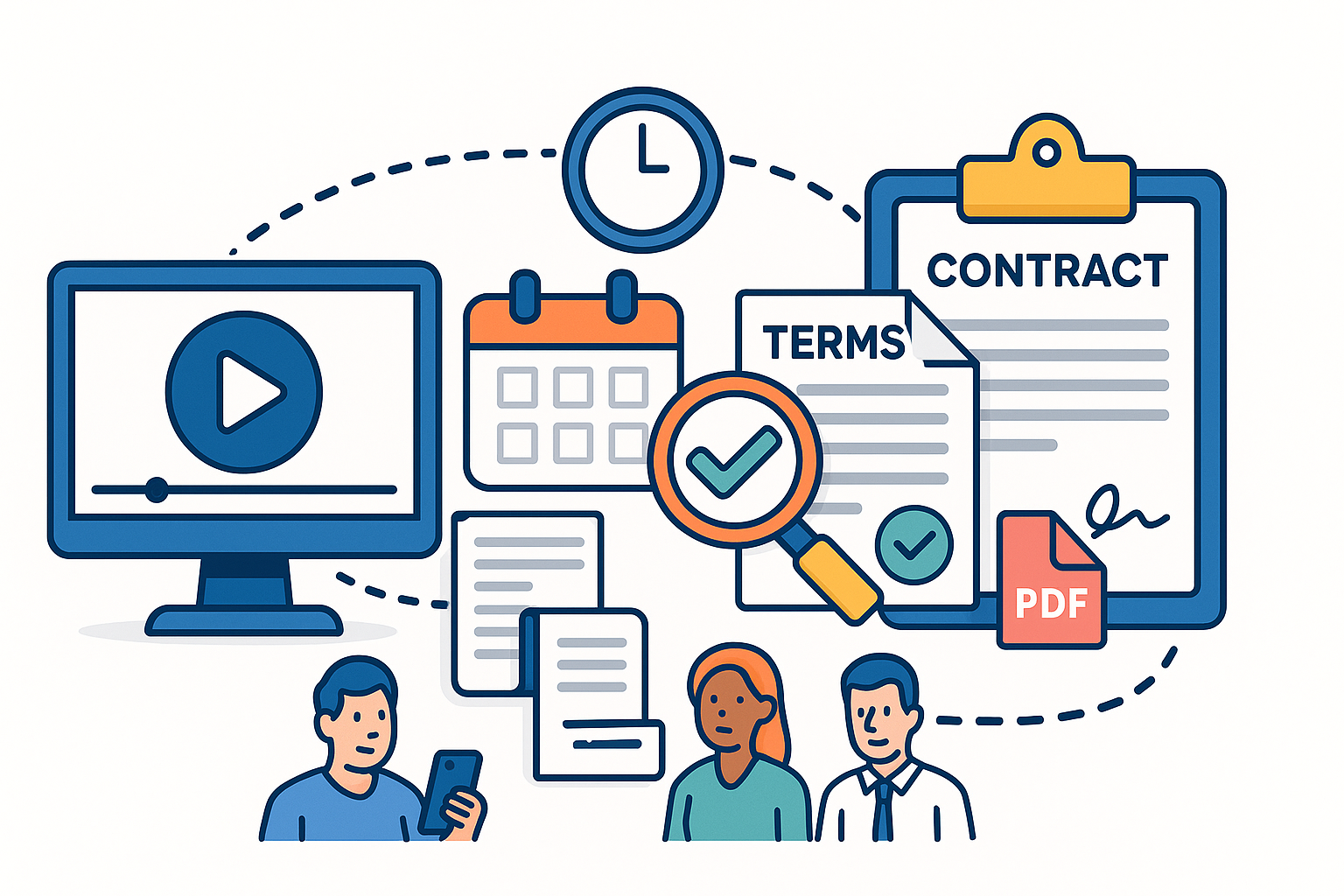Regulators are clear: a signature on its own is no longer enough.
The FCA’s Consumer Duty and the SRA’s Conduct Rules both emphasise that clients must actually understand the agreements they enter into. Courts are increasingly focusing on informed consent, looking for proof that people were given information in a way they could comprehend before accepting. When personal data is involved, the bar is even higher — clear, demonstrable consent is required.
That’s why audit trails need to go beyond electronic signatures. Evidence of understanding, not just acceptance, is now central to compliance. By showing how information was presented, confirming client comprehension, and recording clear consent, you can align with Section 8 of the FCA Consumer Duty, meet SRA obligations, and strengthen your legal position. This approach protects clients and firms alike, reducing risk while building trust.
The FCA’s Consumer Duty sets a clear expectation: firms must do more than disclose — they must ensure that customers understand what they’re being told.
As outlined in the FCA’s Finalised Guidance:
“Consumers can only be expected to take responsibility where firms’ communications enable them to understand their products and services, their features and risks, and the implications of any decisions they must make.”
FG22/5, Section 8.1Traditional methods like dense PDFs, long blocks of legal text, or fine print do little to support real understanding. Under the Customer Understanding Outcome, firms must now design communications that support comprehension — not just compliance.
The FCA emphasises that customer understanding is not optional — it’s central to enabling informed decisions. Their guidance states:
“We want customers to be given the information they need, at the right time, and presented in a way they can understand. This is an integral part of firms creating an environment in which customers can pursue their financial objectives.”
FG22/5, Section 8.3“Firms should ensure that key information is clear, visible and accessible – not hidden within a large volume of material, or hard to find on a website.”
FG22/5, Section 8.12“Communications can be more effective when they meet the following points: Layered, Engaging, Relevant, Simple, Well timed.”
FG22/5, Section 8.13We align with FG22/5, Section 8.24 by providing a platform built from the ground up to help firms prove customer understanding — not just claim it. Our tools integrate directly into key moments such as onboarding, renewals, or decision-making, ensuring information is delivered in context so it’s not only available, but also timely and actionable.
“A firm should provide relevant information at an appropriate stage in the customer journey, giving the customer the opportunity to review the communication before deciding whether to act.”
FG22/5, Section 8.24Layered, plain-English summaries
We break down the key points of complex contracts into short, clear summaries. These are written in plain English and designed to give customers clarity before they reach the fine print.
Multimodal delivery: text, video, audio
Customers can engage with content in the way that suits them best — whether that’s reading, listening, or watching. This helps meet the needs of a wider range of users, including those with low literacy or cognitive barriers.
Real-time comprehension checks
We build in moments of pause — asking the customer to confirm key points, or reflect on what they’ve just seen or heard. This supports understanding at the point of decision, not after the fact.
You don’t just need to support understanding — you need to prove it. Our platform provides:
This gives firms verifiable, time-stamped evidence that they’ve met their obligations under the FCA Consumer Duty Customer Understanding requirement.

Legal professionals are held to high standards when it comes to communication — and the SRA Code of Conduct makes it clear: clients must be in a position to make informed decisions.
The SRA client communication guidelines go beyond disclosure. They require solicitors and law firms to ensure that information is delivered in a clear, accessible and actionable way — especially for those who may be vulnerable or unfamiliar with legal processes.
“You give clients information in a way they can understand. You ensure they are in a position to make informed decisions about the services they need, how their matter will be handled and the options available to them.”
SRA Code of Conduct for Solicitors, Section 8.6Under the SRA’s expectations, ticking a box or signing a retainer doesn’t automatically equal informed consent. Clients must:
"You ensure that clients receive the best possible information about how their matter will be priced and, both at the time of engagement and when appropriate as their matter progresses, about the likely overall cost of the matter and any costs incurred.”
SRA Code of Conduct for Solicitors, Section 8.7This places a clear responsibility on firms to explain costs clearly and regularly, using language and formats that are appropriate for the client.
We’re designed to help legal professionals uphold their duty of clarity and transparency, especially where complexity or client vulnerability might otherwise create risk.
Contextual explanations throughout the matter lifecycle
Unlike static terms buried in PDFs, we help you provide timely, relevant information at key points in the client journey — whether it’s at initial instruction, a cost update mid-matter, or when outlining options before a decision.
This aligns with §8.7 of the Code, ensuring clients are given the best possible information as their matter progresses — not just upfront.
Tools that help clients compare and decide
Whether it’s fixed fees, risk-based costs, or alternative service options, we help present this in clear, comparable formats. Clients can hear, see or revisit their options in formats that reduce confusion and build trust.
This supports §8.6, which requires clients to understand the services, options and implications before acting.
Flexibility for vulnerable clients
We know the SRA expects solicitors to adjust their communication style where appropriate. Our platform enables:
Slower-paced journeys,
Optional voice explanations,
Low-text modes for those with literacy challenges or neurodiverse needs.
These aren't generic tools — they’re practical safeguards that help firms treat all clients fairly.
Built-in auditability for solicitors
Every explanation viewed, every cost disclosed, and every client confirmation is logged. This means your practice has clear evidence that your team:
Communicated clearly,
Provided appropriate cost information,
And supported the client to make an informed decision.
Client-specific presentation of options
Instead of overwhelming clients with everything at once, our platform supports layered communication. You can present choices based on the client’s situation, goals, or stage in the process — helping them understand what’s relevant to them, not just what’s required to disclose.
Many firms rely on electronic signatures to confirm consent — but under current regulatory expectations, a signature alone is no longer enough. It shows someone accepted something, but not that they understood it.
When legal, financial, or personal consequences are involved, especially when processing personal data, regulators expect clear, informed, and meaningful consent.

Under the Electronic Communications Act 2000 and eIDAS, electronic signatures are legally valid across the UK. But neither law guarantees that the contents of a contract were understood — only that they were signed.
Modern compliance frameworks — from the FCA, SRA, and GDPR — are clear:
Understanding must come before consent.
As the Law Society advises:
“It is not enough to assume that because someone has signed something, they have understood it.”
The law requires that consent must be:
Freely given – not bundled into general terms
Specific – clearly tied to the data being processed
Informed – the individual knows exactly what they’re agreeing to
Unambiguous – no hidden clauses or vague language
If your contract includes any personal data processing (including analytics, tracking, or third-party sharing), you must be able to prove that the client understood what they were agreeing to.
❗ Hidden or misunderstood clauses may not constitute valid consent under data protection law.
If challenged — by a client, the ICO, or a regulator — you’ll need more than a checkbox or digital signature. You’ll need to demonstrate that the person:
Had access to the right information
Understood what was being asked
Made a clear, informed decision
This is particularly important for:
Financial services agreements
Legal service terms
Data processing disclosures
Vulnerable clients
Whether you're meeting Consumer Duty, SRA Code of Conduct, or UK GDPR, the standard is the same:
Consent must be clear, informed, and provable.
With  i agree , you don’t just get a signature — you get evidence of understanding.
i agree , you don’t just get a signature — you get evidence of understanding.
Recent UK court decisions are reshaping what "agreement" really means. These cases make clear that a signed contract is no substitute for genuine understanding:
In this landmark decision, the Court of Appeal found that solicitors must exceed standard terms and conditions to ensure fee deductions were consented to with full understanding. A signed agreement was not enough—there needed to be clear, proactive explanation of what was being agreed to.
The court sided with the consumer in a case involving unclear fee structures. It emphasised that professionals must ensure clients genuinely grasp their financial and legal obligations.
In this case, hidden fees buried in the fine print of a finance deal were ruled unfair. The court found that simply including terms in small print wasn’t enough to make them enforceable against consumers.
Key takeaway
A signed contract wasn’t enough. The court expected clear, proactive explanation.
Key takeaway
Legal professionals are expected to ensure clients genuinely grasp key obligations, especially where their financial rights are affected.
Key takeaway
Fine print isn’t protection. Terms must be clear and properly brought to the consumer’s attention.

Every interaction within an  i agree's contract is logged, timestamped. You get:
i agree's contract is logged, timestamped. You get:
Click paths, video views, confirmations
Repetition tracking for key clauses
Records of all accepted terms and summaries
Exportable PDFs for regulators
Recorded consent for dispute resolution
This creates a powerful layer of protection in any investigation, audit, or litigation — showing not just the intent, but every component of the informed decision.
The FCA requires firms to do more than disclose information — they must present it in a way customers can genuinely understand. Firms must give customers the right information, at the right time, and in the right format to support informed decision-making.
No. While electronic signatures are legally valid, regulators like the FCA, SRA, and ICO now expect firms to show that the individual understood what they were agreeing to — not just that they signed.
You can prove understanding by showing that content was presented clearly (in plain English), offered in multiple formats (text, audio, video), and confirmed through engagement — such as prompts, checkboxes, or verbal confirmations.
The SRA Code of Conduct states that solicitors must give clients information in a way they can understand, allowing them to make informed decisions. This includes explaining services, pricing, and options clearly and adapting communication for vulnerable clients.
Consent under GDPR and the UK Data Protection Act 2018 must be freely given, specific, informed, and unambiguous. Hidden or misunderstood clauses don’t count — and you must be able to prove that the user understood what they were consenting to.
 i agree help firms comply with Consumer Duty and SRA rules?
i agree help firms comply with Consumer Duty and SRA rules?
 i agree breaks down complex legal language into layered, plain-English summaries and delivers content through video, voice, and text. It captures time-stamped engagement data, comprehension prompts, and a full audit trail — proving that the user understood what they agreed to.
i agree breaks down complex legal language into layered, plain-English summaries and delivers content through video, voice, and text. It captures time-stamped engagement data, comprehension prompts, and a full audit trail — proving that the user understood what they agreed to.
Our platform supports different learning and communication needs by offering voice explanations, video summaries, and slower-paced journeys. This helps ensure that even clients with accessibility challenges can understand and engage with key terms.
With  i agree, you can produce an exportable audit trail showing exactly what the client saw, heard, and confirmed — including timestamps, playback logs, and proof of comprehension. This can be used to support your position in audits, disputes, or litigation.
i agree, you can produce an exportable audit trail showing exactly what the client saw, heard, and confirmed — including timestamps, playback logs, and proof of comprehension. This can be used to support your position in audits, disputes, or litigation.
If you have more questions, take a look at our full FAQs page where we cover a wider range of topics in more detail. It’s a quick way to find answers and explore other subjects that might be useful to you.


